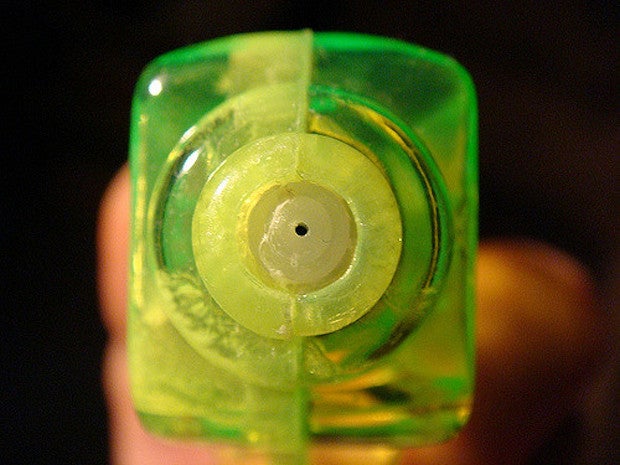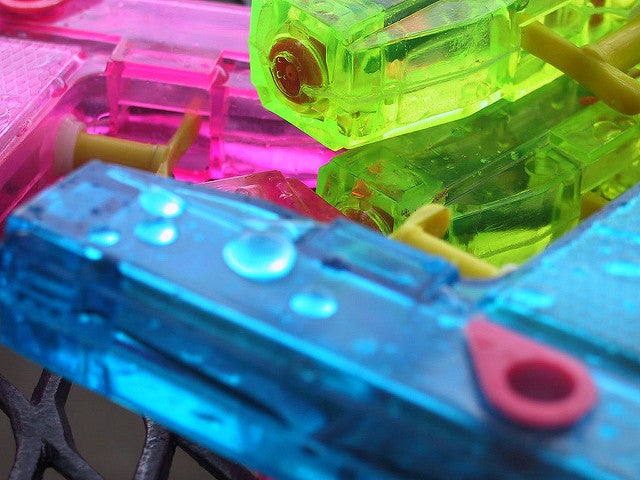by Wendy Kennar

Before our son was born, my husband and I made a conscious decision that all toys in our home would be toys—meaning they would be fun, or silly, or creative, or educational, or all of the above. We didn’t want Ryan’s toys to resemble any sort of weapons. Whether it be a small toy gun, a plastic water gun, or a Nerf gun, they all reference guns. And no good comes from guns.
We had made it nine years before Ryan questioned our family value banning toy weapons.
It all started because of the goodie bag Ryan received at his classmate’s birthday party. As we drove home from the party, Ryan sat in the backseat, looking through his green goodie bag.
“Lots of candy I don’t like, but we can see if Daddy wants it.” A pause, and then, “Mommy, look what they gave me,” Ryan said.
I looked into the rearview mirror and saw a small orange water gun staring back at me from its sealed plastic bag.
“Hmm,” I said.
As a former teacher, the sight of this “toy” made me seethe, and my internal dialogue began. Of all the toys, and that’s what these parents passed out? There are so many more educational, beneficial toys out there that cost the same (or less) than this water gun. What about a small magnifying glass, a yo-yo, some bubbles, or a bookmark?
From the backseat came Ryan’s voice.
“I know our family has never had these kinds of toys, but I’m curious, and I’d like to keep it, please.”
I stalled the conversation until dinner so we could discuss it as a family. But it really wasn’t just about a toy gun. It was about allowing our child to learn, to discover, to make his own choices, while respecting ours. Ryan wanted to play with something his dad and I felt very strongly against. It was about navigating the fine line of not making something off-limits and forbidden until it became incredibly appealing.
I found myself thinking about a former colleague. Growing up, Schyler’s family had never allowed her to drink soda. But when she went off to college, living on her own and making her own decisions meant she could drink soda any time she wanted. So she did. She drank it at every meal. Including breakfast.
I didn’t want toy guns to become Ryan’s soda.
We didn’t tell Ryan no. Instead, we asked him why. Why did he want this toy?
I was impressed that Ryan had several reasons to give us besides, “I want it.”
“A lot of my friends play with different kinds of guns.”
“I’ve never played with one before, and I’m interested.”
“It doesn’t look like a real gun.”
“I’ll only play with it once in a while.”
“The world was undeniably a different place, and our parenting decisions were a reflection of the terrifying realities facing us.”
Then it was our turn. I asked Ryan to think about some of his favorite toys.
His basketball, his remote control Super Mario car, his toy cash register, his Toy Story friends.
I asked, “Would anyone be scared of them or offended by them?”
He shook his head no. They were all either fun, or silly, or creative, or educational.
“Ryan, Daddy and I made this decision before you were born. Nothing good comes from guns. Guns injure. And guns kill. Every day, all around the world, someone is hurt or killed by a gun. Sometimes by accident. Sometimes not. And I think that when kids keep using gun-like toys, they forget what damage real guns do.”
I thought I had presented our case well. I thought the discussion would be over. I thought wrong.
“I know,” Ryan said. “But I’m still wondering, and I’d still like to play with it.”
We ate dinner and intermittently continued our conversation. I knew this discussion was just the beginning. Whether it was eating Hot Cheetos or owning a cell phone, Ryan would continue noticing his friends have things and do things that he didn’t. I wanted Ryan to understand where our family stood on these issues, and I wanted him to feel confident being the kid who says, “No thanks. My family doesn’t allow that.”
The world was undeniably a different place, and our parenting decisions were a reflection of the terrifying realities facing us.
My parents’ generation had practiced duck-and-cover drills. (Thankfully they never needed them).
My son’s generation practices lockdown drills. (And they use them. Often).
In 2012, I was teaching fourth grade in California, when across the country innocent first graders were shot and killed while in their classroom.
The next day, my students wanted to talk about it. We talked about the ways our school tried to maintain a safe campus. We talked about areas that could be improved, such as locking up the gates a little faster after the morning bell. And we talked about what would happen if someone came into our classroom and started shooting.
“We’d be on lockdown if someone unsafe was on campus. Our doors would be locked, windows and blinds closed, and we’d be huddled on the floor in the middle of the classroom.”
“But what if someone got up here before the lockdown? What if someone with a gun showed up in our classroom?”
My thirty-plus students, ages nine and ten, looked at me. They weren’t just asking me a hypothetical question.
“What’s my number one job?” I asked them.
“To keep us healthy and safe,” they replied in unison. They’d heard this since the very first day of school and now it was December.
“So I’d do what I had to do to keep you healthy and safe. If I had to, I’d take the bullet.”
They gasped.
“What about Ryan?” they asked.
They knew about my then-four-year-old son, because I often talked about him in class.
“When I’m at home, my job is to keep Ryan healthy and safe. When I’m at school, my job is to keep all of you healthy and safe.”
“I think that when kids keep using gun-like toys, they forget what damage real guns do.”
And now my son was sitting next to me at the dining table telling me he wanted to play with a toy gun.
We finished our meal, and I found both my son and my husband looking to me. Paul weighed in with a decisive, “In this house, we don’t play with those kinds of toys.” But as a former teacher, I knew that kind of response wouldn’t work. Ryan needed more than that.
“Okay Ryan, here’s the compromise,” I began. “If you want to open up this water gun because you’re curious, because you’ve never seen one up close or held one, then do it.”
Again, both my husband and my son looked to me, wondering what I was saying and why. “Go to the bathroom sink, fill it up, play with it in the sink, and see what it does. Satisfy your curiosity. And when you’re done, it goes in the trash. We are not keeping this toy.”
Ryan quickly took the orange water gun into the bathroom, and Paul and I began clearing off the dining table and cleaning up the kitchen. I wanted Ryan to have his space, to explore and try this out for himself without us hovering over him.
Within a few minutes, we heard Ryan’s voice from the bathroom. “Guys, this isn’t fun.”
I smiled at Paul and walked over to see what Ryan wanted to show us.
“This doesn’t work well. Hardly any water comes out. Look.” Ryan sprayed my hand with what felt like a trickle of water dripping from a sink faucet that hadn’t been turned completely off.
Ryan continued, “It’s not fun at all. I don’t want this.”
And he took the water gun, threw it in the trash and went to the couch where he continued reading his Diary of a Wimpy Kid book.

This piece previously appeared in MUTHA Magazine: Exploring real-life motherhood, from every angle, at every stage.
Read more: